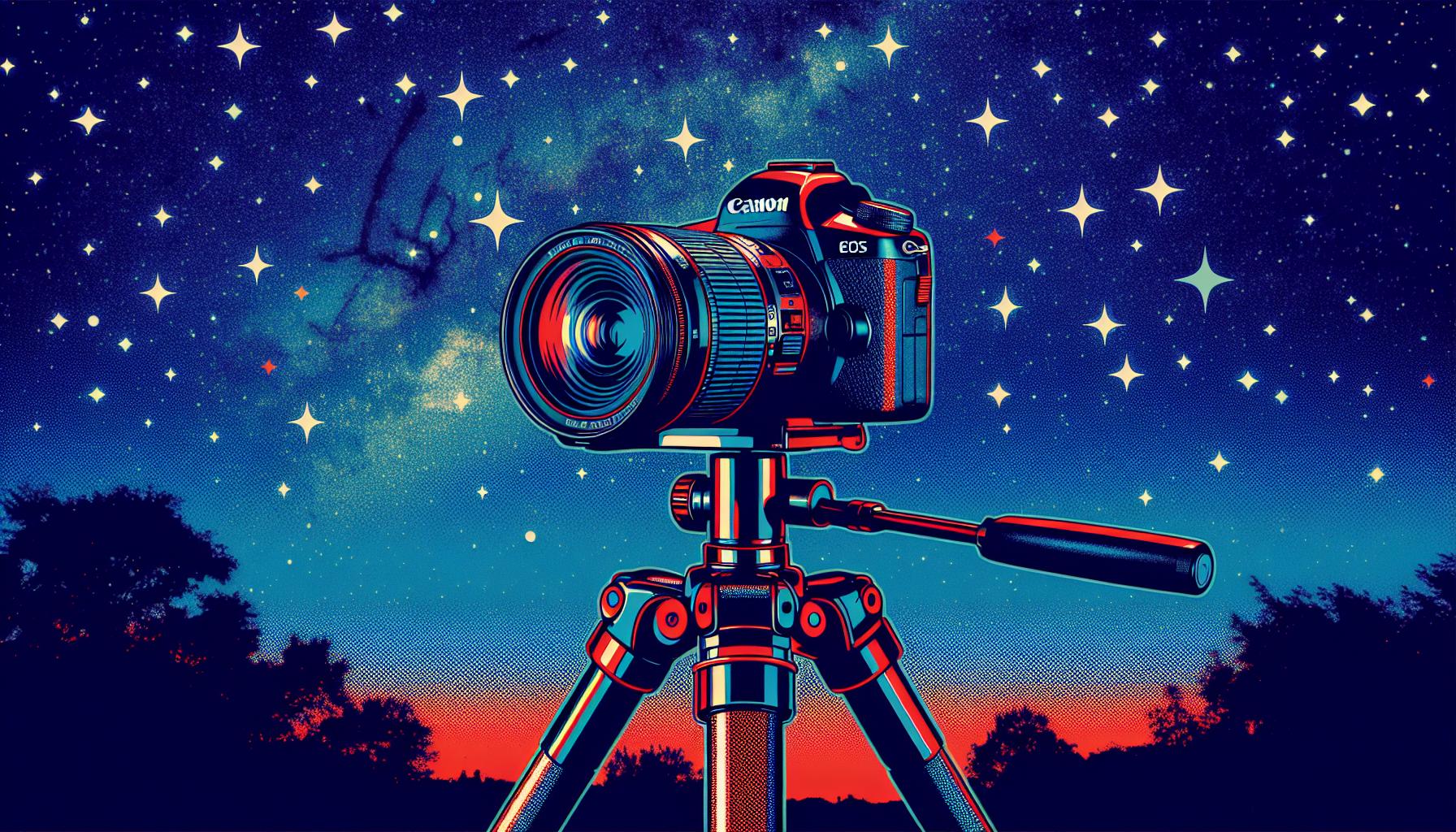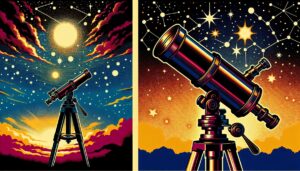This site contains affiliate links to products. I may receive a commission for purchases made through these links.
As an avid astrophotographer, I’ve found the Canon EOS RP to be a game-changer. This full-frame mirrorless camera has features that make it a standout choice for anyone venturing into the captivating world of astrophotography.
The EOS RP’s exceptional low-light performance and high ISO capabilities are just the beginning. It’s the combination of these features with the camera’s impressive range of compatible lenses that truly sets it apart.
Whether you’re a seasoned pro or just starting out, the Canon EOS RP offers a unique blend of versatility and performance. It’s a camera that can help you capture the cosmos like never before.
Canon EOS RP Overview
Stepping into the world of astrophotography, I’ve found that the ideal tool within arm’s reach is often the Canon EOS RP. This full-frame mirrorless camera promises an unforgettable stargazing experience with its expansive possibilities.
The EOS RP’s compact size is a game-changer, proving that high-end performance doesn’t rely solely on big and heavy gears. Its portability cannot be overlooked making it particularly handy for outdoor, nocturnal photography sessions under the broad, star-lit sky. When I’m out in the field, it’s essential that my gear is both portable and durable. The EOS RP’s design doesn’t frustrate.
Beyond the size and weight, the high-performing 26.2-megapixel full-frame CMOS sensor is what grabs the spotlight. This is where the EOS RP truly shines, especially during low-light situations such as night sky photography. Paired with the DIGIC 8 image processor, this camera is capable of producing superb high-ISO images that bring out the celestial bodies in vivid detail.
Lens compatibility is another aspect where the EOS RP stands where many counterparts fall. Its broad range of compatible lenses has allowed astrophotographers like me to capture a variety of celestial phenomena. With the newly developed RF mount, I can use both RF lenses and EF/EF-S lenses (using optional adapters) with minimal loss of quality, widening the horizon for multiple compositions.
The EOS RP’s impeccable low-light performance combined with its versatile lens compatibility implies it’s perfectly cut out for astrophotography. Yet, it comes with additional features that are worth exploring. Let’s discuss them in subsequent sections.
We’ll delve further into the features and benefits that the Canon EOS RP brings to astrophotography, including specifics like the in-built focus peaking and focus magnification tools. Together, they help ensure that my shots of the starlit sky are not only stunning but also sharp and precise.
Moreover, we’ll look at how the EOS RP stacks up against comparable models in the market. That’s important considering its relatively budget-friendly price tag in the full-frame territory. One thing is certain: The EOS RP is a camera that is serious about astrophotography. It’s not all talk. It walks the walk.
Key Features for Astrophotography
First and foremost, let’s talk about one of its biggest assets – the 26.2 MP full-frame CMOS sensor. With more pixel space, this camera is able to capture intricate details often present in star shots and other celestial images. Coupled with the DIGIC 8 image processor, it creates brilliant high-ISO images, crucial during low-light scenarios. It’s these two components working in harmony that really bring the night sky to life.
To assist in the accurate capture of celestial bodies, the EOS RP comes with a powerful focus magnification tool and focus peaking. These are significant features for any astrophotographer as they allow for precise focusing on stars, even under not-so-optimum conditions.
An in-built feature to note is the Vibration Reduction function. That means, despite the inherent instability that can come with outdoor, on-the-go photography, you get crisp, clear, and still photographs. Add a sturdy tripod into the mix and you’re all set to capture the cosmos at its best.
Lastly, let’s highlight the versatile range of compatible lenses. The EOS RP uniquely works with both RF lenses and EF/EF-S lenses, avoiding any noticeable decrease in quality. Thus, it vastly increases the range and perspective that you can bring to your astrophotography.
Let’s summarize these key features within a table for a quick overview:
| Camera Feature | Benefits for Astrophotography |
|---|---|
| 26.2 MP Full-frame CMOS Sensor | Capture intricate details present in star shots |
| DIGIC 8 Image Processor | Produce high-ISO images in low light |
| Focus Peaking & Magnification Tools | Precise focusing under diverse conditions |
| Vibration Reduction | Crisp and clear photos, preventing blurs from instability |
| RF & EF/EF-S Lens Compatibility | Broaden range and perspective in images |
In the coming sections, we’ll delve into how the scalability of the EOS RP’s features can enhance your overall experience with astrophotography. We’ll talk about using the camera in real-world conditions, providing insights from experienced astrophotographers.
Low-Light Performance
Switching gears, let’s consider the Canon EOS RP’s low-light performance. A camera’s ability to perform under low light conditions becomes a key determinant for any astrophotographer. As the night sky, typically dim and distant, poses unique challenges, the choice of camera assumes added significance.
One of the main advantages of the EOS RP is its solid low-light capabilities owed to the 26.2 MP full-frame CMOS sensor and DIGIC 8 image processor. These features equip the Canon EOS RP for astrophotography by allowing it to produce high-ISO images in low light without significant noise reduction. Details are preserved, and images come out clean and clear.
What makes the camera stand out is the luxury to bump the ISO up to 40,000 (expandable up to 102,400). This power to amplify sensor sensitivity can procure usable images even in near darkness.
The camera also incorporates a feature called focus peaking and focus magnification, which simplifies the task of achieving precision focusing on stars. The vibration reduction capabilities ensure that blurring of images due to instability is reduced to minimum.
With the EOS RP, Canon has taken care to address the pain points astrophotographers commonly face in capturing star shots, namely focus and stability. I’ve found these features particularly useful in my astrophotography ventures.
Let’s dive a bit deeper and explore how to maximize the EOS RP’s low light capabilities during real-world astrophotography sessions, and let’s hear insights from experienced astrophotographers on their experience using EOS RP for astrophotography.
High ISO Capabilities
Plunging into the heart of Canon EOS RP’s astrophotography prowess brings me to its high ISO capabilities. An often-overlooked aspect of successful astrophotography is the camera’s sensitivity to light or in technical terms, its ISO prowess.
The EOS RP’s ISO range of 100 to 40000 – expandable to an impressive 102400 – offers immense flexibility. This means it’s not just about capturing detailed shots of the night sky but also making them crisp and noise-free. Its sensitivity to light ensures that even in the darkest conditions, the camera can still detect and capture light from fleeting stars and other celestial bodies.
Let’s discuss some comparative data to illustrate this point:
| ISO Level | Image Quality | Utility |
|---|---|---|
| Low (100-800) | High detail, low noise | Ideal for bright skies |
| Mid (800-6400) | Balanced detail and noise | Suitable for twilight or moonlit nights |
| High (6400-40000) | Less detail, high noise | Useful for capturing deep-sky objects in dark conditions |
| Extended (102400) | Lower detail, extreme noise | Potential usage under extremely dark skies |
What sets the EOS RP apart is that even at higher ISO levels, the images reveal an admirable amount of detail and contrast. This is attributable to the camera’s top-tier DIGIC 8 image processor. It is worth mentioning that while the allure of higher ISO levels may seem tempting, astrophotographers should tread with caution. Every increase in ISO comes with an increase in image noise, which might require post-processing work to alleviate.
The option to push the ISO to greater heights will invariably leave furrows on the brow of any seasoned photographer. Still, it is an insurance policy that promises enough light will be gathered, especially when conditions are less than perfect. That, in a nutshell, is what makes the Canon EOS RP an astrophotographer’s delight. Valuing practical applicability and real-world results, it offers more than its competitors can only dream of.
Range of Compatible Lenses
Not only does the Canon EOS RP excel in its ISO capabilities, but it also offers a broad selection of compatible lenses. These lenses further enhance the astrophotography experience by providing various focal lengths and apertures. Here’s a walk through some of the lenses you might find useful for this purpose.
High on the list is the RF 15-35mm F2.8 L IS USM. Its wide angle allows for capturing expansive starry landscapes, while its fast aperture enables more light collection. Now, that’s an impactful combo for low-light photography.
Next we have the RF 24-105mm F4 L IS USM. It’s versatility in focal length is great for varied astrophotography scenarios. It doesn’t have the same fast aperture as the RF 15-35mm – but you’ll find it adequately compensates for that with its image stabilization feature.
Then there’s the EF 16-35mm f/2.8L III USM. Now, you might notice that this one’s an EF lens, not RF- but no worries! The EOS RP supports using EF lenses with an adapter. This lens truly shines with its ultra-wide-angle views and bright aperture, perfect for capturing wide-field astronomical images.
Lastly, let’s acknowledge the RF 50mm F1.2 L USM. This prime lens with its super-fast aperture is a marvel in capturing detailed images of celestial bodies.
Remember, using these lenses with the robust 26.2 MP full-frame CMOS sensor, and DIGIC 8 image processor of the Canon EOS RP certainly elevates your astrophotography game.
Tips for Astrophotography with the Canon EOS RP
Firstly, utilize the camera’s full ISO range. Although high ISO can bring about image noise, balancing it right can lead to some incredible night-sky images. However, like it’s crucial not to be afraid of pushing ISO when necessary, not pushing it too far is equally important. Find the sweet spot between light capture and noise level for your shooting style and conditions.
When shooting at night, your lens’s aperture comes into play. The wider you can open your aperture, the more light your camera can absorb. Choosing the proper lens, such as the RF 50mm F1.2 L USM with the Canon EOS RP, allows maximum light intake.
Now that we’re on lenses, all astrophotographers should know the importance of having a good focus on your stars. Zoom in on your live view and manually focus until the stars appear sharp. Features like focus peaking and focus magnification in the Canon EOS RP come in handy.
Lastly, invest in a sturdy, reliable tripod. This should go without saying but, when your camera is taking long exposures to capture those stunning stars, any shake or instability can blur the whole image. The vibration reduction function in the Canon EOS RP lends an extra degree of stability.
Remember, astrophotography is an art as well as a science. Experiment, adapt, and find what settings and techniques work best for you. The Canon EOS RP offers the flexibility and tools necessary to capture truly exceptional images of the night sky, making it a fantastic choice for any astrophotographer.
Conclusion
The Canon EOS RP is a strong contender in the realm of astrophotography. Its 26.2 MP full-frame sensor and DIGIC 8 processor are a potent combination for capturing the night sky’s finest details. The added benefits of focus peaking and magnification tools enhance precision, while vibration reduction keeps shots clear.
Don’t forget, the key to the best star shots lies in experimenting with the full ISO range, selecting a wide aperture lens, and investing in a reliable tripod. The Canon EOS RP isn’t just a camera – it’s your ticket to unlocking the universe’s beauty. So, grab your gear and start exploring the cosmos through your lens.
Frequently Asked Questions
What makes the Canon EOS RP good for astrophotography?
The Canon EOS RP is adept for astrophotography due to its 26.2 MP full-frame CMOS sensor and DIGIC 8 image processor, these two work together to capture intricate star details, and produce high-ISO images in low light. The camera also offers focus peaking and magnification tools for better star focusing and a vibration reduction function to avoid blurs.
What tools does the Canon EOS RP offer for focus precision?
The Canon EOS RP offers focus peaking and focus magnification tools. These tools aid in achieving perfect focus on the stars by magnifying the subject and outlining it with a color halo once it’s in focus.
How to make the most of the Canon EOS RP for astrophotography?
You can maximize your astrophotography experience using the Canon EOS RP by utilizing the full ISO range, opting for a lens with a wide aperture, and investing in a solid tripod. Experimentation is crucial to finding the best settings and techniques for your shots.
Why is a sturdy tripod necessary for astrophotography with the Canon EOS RP?
A sturdy tripod is necessary for astrophotography as it provides stability, preventing movement of the camera during long exposures. This is particularly important with the Canon EOS RP, as slight movements can cause blur in the final image.




